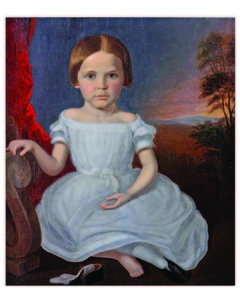

This portrait by Samuel Shaver was found in Blountville, Tenn., and may be a member of the Anderson family.
Sitting for portraits can try one's patience, illustrated by the discarded shoe and fierce glare of concentration on the face of this young sitter (pictured in lower right). Her charming portrait was found in Blountville, Tenn., and research suggests she may have been a small member of the Anderson family there. The artist, whose patience was also perhaps being taxed, was Samuel Shaver.
Shaver probably painted her portrait during the 1850s when he lived and worked in Rogersville, a Northeast Tennessee town near Blountville. A prolific painter, his portraits still exist today on the walls of private homes and museum galleries.
He did quite a lot of paintings of children, both individual sittings like this one, as well as groups of siblings. He also painted parents with their children. In all of these, the children have an adult look about them, especially heads that appear overly large and somber facial expressions. He usually worked on linen canvas; and his portraits, though unsigned, are recognizable to the collector. Early ones display a slightly flat style, but his later work adopted a softer tone and more elaborate detailing, as well as the addition of background scenes of local places or draperies like the red one behind our little sitter.
Samuel Shaver was born in 1816 in Sullivan County, Tenn., to David and Catharine Berringer Shaver. His paternal grandparents were from Germany, arriving in America some time before 1750 and ultimately settling in western North Carolina. His parents moved to Abingdon, Va., around the turn of the century but left there before many years and built a home near Kingsport, Tenn., that they named Rock Ledge where young Samuel was probably born.
Michael Shaver was Samuel's uncle who had been a part of the family's early move to Abingdon, where he remained for the rest of his life, serving on its town council and working as a silversmith, jeweler, blacksmith and even a dentist. Samuel was only 22 when he utilized this Abingdon connection to place an ad alongside one of his uncle's in Abingdon's Virginia Statesman newspaper announcing himself available as a "portrait and miniature painter."
In 1845, Samuel married, and this event was possibly the key to his ultimate success. His bride was Mary Hannah Elizabeth Powel from Rogersville. Mary's father was a congressman, and the connections Samuel acquired through her family gave him numerous commissions. He also accepted a teaching position in art at Rogersville's Odd Fellows Female Institute, referring to himself as "Professor Shaver," gaining more credibility as an artist. Sadly, Mary died after 10 years of marriage. Samuel continued painting portraits in and around Rogersville for a few years thereafter; but in 1859 he moved to Knoxville, perhaps seeking a broader clientele for his portraits and where, indeed, he became well known.
In 1870, he moved to Illinois where his mother-in-law was living with his children. He was still painting, the census records that year noting him as a "portrait painter." Samuel Shaver died in Illinois in 1878.
Samuel Shaver, Portrait Painter is adapted from "Backcountry Makers: An Artisan History of Southwest Virginia & Northeast Tennessee." This is the fifth in a series of articles related to this new book by Betsy K. White. Featuring more than 200 color images, it is currently in publication by the University of Tennessee Press. "Backcountry Makers" is White's second book on the history of the region's material culture. The first, "Great Road Style: the Decorative Arts Legacy of Southwest Virginia & Northeast Tennessee" was published in 2006 by the University of Virginia Press.